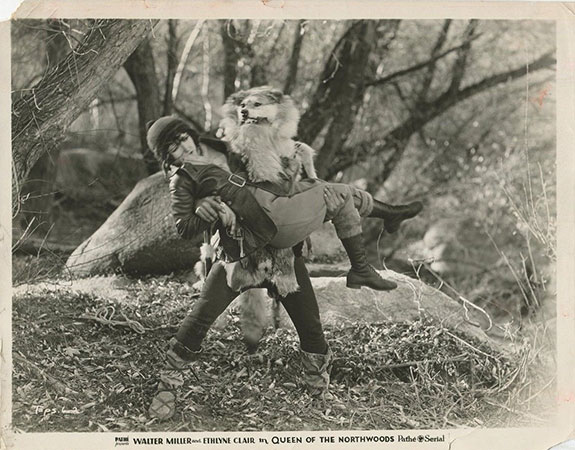Q …is for
Queen of the Northwoods

Diane Moreau (Ethlyne Clair) is the target of the “Wolf Devil”, one of the most frightening and original of the serial villains.
The serial films of the 1910s to mid-1920s had featured a variety of disguised and threatening villains, from the Clutching Hand in The Exploits of Elaine (1914) and the Silent Menace in Pearl of the Army (1916) to the Automaton in The Master Mystery (1919), the skull-faced marauders in The Moon Riders (1920), and the fur-coated, fur-hatted phantom in The Phantom Foe (1920). Few, however, were more fearsome than the Wolf Devil.
One of film’s wolf-men (that is, men who assumed the guise and demeanor of a wolf—the precursor to the later and more common werewolf, who transforms from a man into a beast), the Wolf Devil wears a scary animal headdress that completely covers his face and preserves his anonymity and a large wolfskin that shields and protects his torso. Through his unique but unexplained ability to control a pack of wolves (who howl in response to his voice), he also enjoys a connection to the supernatural, which makes him even more menacing. Although the serial was not the first to utilize a northern location—Perils of the Yukon (1922), Nan of the North (1922), and Wolves of the North (1924) had all used similar settings—it was certainly distinctive in its attempt to combine that locale with elements of the supernatural.
Queen of the Northwoods director and producer Spencer Gordon Bennet was among the most prolific and respected serial directors of the 1920s. A member of the original Biograph Company, he had risen through the ranks, from stunt man and supporting actor to assistant and ultimately director at Pathé. He quickly earned a reputation for turning in productions, on budget and on time, that relied as much on successful story development as on stunts. His adaptation of Edgar Wallace’s The Green Archer (1925), for example, kept moviegoers in suspense as to the identity of the mysterious eponymous character who seems to haunt an old castle; and subsequent serials of his such as Hawk of the Hills (1927) introduced other interesting plot twists, intrigues, and unusual locations.
Appearing in Queen of the Northwoods was another dependable screen veteran, Walter Miller, Pathé’s reigning hero for much of the 1920s. Miller had earlier teamed with actress Allene Ray to create a popular all-American duo whom audiences clamored to see. In films such as The Green Archer, The House Without a Key, and The Man Without a Face, the two became what Ed Hulse called “Partners in Perils” and brought new luster and excitement to the familiar serial form. In Queen of the Northwoods, Miller was teamed with a different partner, the rising star, Ethlyne Clair. A former art student and WAMPAS (Western Association of Motion Picture Advertisers) Baby Stars alumna, Clair had appeared in a number of serials, including several Westerns where she played the love interest of Hoot Gibson.
Unfortunately, by the time that Queen of the Northwoods was released, the film industry was already making the transition to sound movies. The silent serial drama and adventure was on the wane, and even productions such as Pathé’s The Fire Detective, a serial directed by Spencer Gordon Bennet and Thomas L. Storey based on a story by veteran scenarist Frank Leon Smith (intended to be the first serial with synchronized sound sequences), did not revive interest in the genre. And while select serials—among them, Westerns, science-fiction, and jungle pictures—continued to draw audiences, the genre no longer held the same wide appeal that it had a decade earlier. In fact, not long after Queen of the Northwoods wrapped, Pathé—producer of such pioneering action, mystery, preparedness, and Western serials as The Perils of Pauline, The Exploits of Elaine, Pearl of the Army, The Shielding Shadow, The House of Hate, Ruth of the Rockies, and The Green Archer—went into receivership, a corporate victim of the Great Depression.
Survival Status: According to Progressive Silent Film List, a print exists (but does not indicate where). A fragment can be viewed on YouTube. Serial chapter excerpt – https://www.youtube.com/watch?v=KYYVzxmu-Z0.
Directors: Spencer Gordon Bennet, Thomas L. Storey
Release Date: May 21, 1929
Release Company: Pathé Exchange
Cast: Walter Miller (Inspector Steele), Ethlyne Clair (Diane Moreau), Tom London (Garvin, also known as The Wolf Devil), Frank Lackteen (Jacques De Brun), Edward Cecil (Fergus), George Magrill (Sergeant Bolt), Nelson McDowell (“Flapjack”), Jean Diamond (Moon River Lady), Arthur Taylor, Fred Burns, Arthur Dewey.
Episodes: (two reels each) 1. The Wolf Devil’s Challenge. 2. A Bottomless Grave. 3. Devil Worshippers. 4. Wings of Death. 5. The Wolf Devil Strikes. 6. The Leap of Death. 7. The Flaming Peril. 8. Brand of the Beast. 9. Trapped by the Fiend. 10. The Den of Evil.
